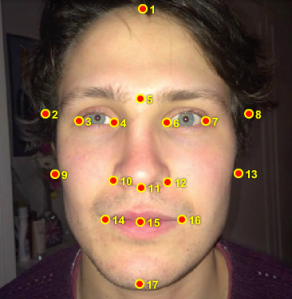Beauty is something we are all familiar with and can recognise. Despite the saying “beauty is in the eye of the beholder” – a lot of people can perceive when a person is beautiful or not, even if that person isn’t to your specific ‘taste’. But why do we have that perception? How do we know someone is beautiful? What instinctive attraction happens in which we can decide whether a person is beautiful or not?
Is it possible for one mathematical ratio to depict how we perceive beauty in the world? Yes – and here is how:
The Golden Ratio.
C divides the line segment AB according to the Golden Ratio
The Golden ratio is found by dividing a line into two parts so the longer part divided by the smaller part sums to the whole length of the divided longer part. The number of the Golden ratio is that of Phi Φ: 1.618. This number also goes under other names such as the Golden mean and Divine proportion.
The Golden ratio has had extensive significance in so many things around us: the Great Pyramids, the Parthenon, art (such as Leonardo da Vinci’s ‘Vitruvian Man’, ‘Mona Lisa’ and ‘Last Supper’), flower petals, the curvature of elephant tusks, pinecones, shells, the Milky Way, hurricanes, DNA molecules and even the length of our fingers. The list is endless…!
But for the purpose of this blog post, I am focussing on the science behind how we perceive beauty in a person’s face.
The Golden ratio is used to achieve balance. Studies have found that when people are given random faces to look at, the ones deemed most attractive follow the proportions of the Golden ratio; the width of the face, eyes, nose and eyebrows. This is why we deem models to be more beautiful – as their faces tend to find Golden ratio proportions better than the average population. So, the immediate decision about whether we’re attracted to someone is a mathematical process, defining what proportions of the face are best.
The mask of the human face is based on the Golden ratio. The proportions of the length of the nose, the position of the eyes and the length of the chin, all conform to some aspect of the Golden Ratio.
When looking at the human face, the head forms a golden rectangle with the eyes at its midpoint. The mouth and nose are placed at golden ratios to the distance between the eyes and the bottom of the chin. Our brains are tuned to symmetry and balance and we are attracted to this. We consider a good face one that projects Golden ratio symmetry.
- Asian
- Black
- Caucasian
- 1350 B.C. Egypt
- 500 B.C. Greece
- 164 A.D. Rome
- 1794 A.D.
There are many other variations in the beauty of a face, such as showing emotion. When a person smiles, their face conforms most closely to phi proportions. You are (unsurprisingly!) perceived more beautiful when smiling than angry.
My own experiment!
I thought I would put the maths into practice myself using a person I deem attractive – my boyfriend! Having roped him into being my model for this, I tested to see how “mathematically” attractive he actually is!
- Original image
- Image with a Golden ratio mask overlay. NB: This is a female mask so proportions will be slightly off (an interactive one was impossible to find!)
As the mask suggests there is a relatively good fit, except his face is a little longer. The proportions of his face fit the geometrically appealing mask proportions, based on the Golden ratio.

http://www.anaface.com Golden ratio face scoring programme
So, the closer the symmetry of your face is to 1.62, the more beautiful you are meant to be. I then used an online calculation of these ratios on my boyfriend to find out how close (out of 10) his face was to the Golden ratio, via calculation rather than a mask. You can find out what your calculation is at http://www.anaface.com!
According to the results, he scored 8.94 out of 10. So, his face is closely proportioned to the Golden ratio of 1.62.
Interestingly, the programme feeds back results as to where his face is in proportion and where it isn’t: his face had ideal nose length to ear length and also mouth width to nose width. However, his face is deemed too narrow/long and his innerocular distance is too big for his eyes.
From the face masks, tests and my own research it turns out there is such a thing as ‘beauty’ by science in the form of the Golden ratio. This was a very interesting and personal insight into the uses of the Golden ratio and our perception of beauty.
Note: The Marquardt Beauty Mask illustrations above are copyright 2001 by Dr. Stephen Marquardt at Marquardt Beauty Analysis.








